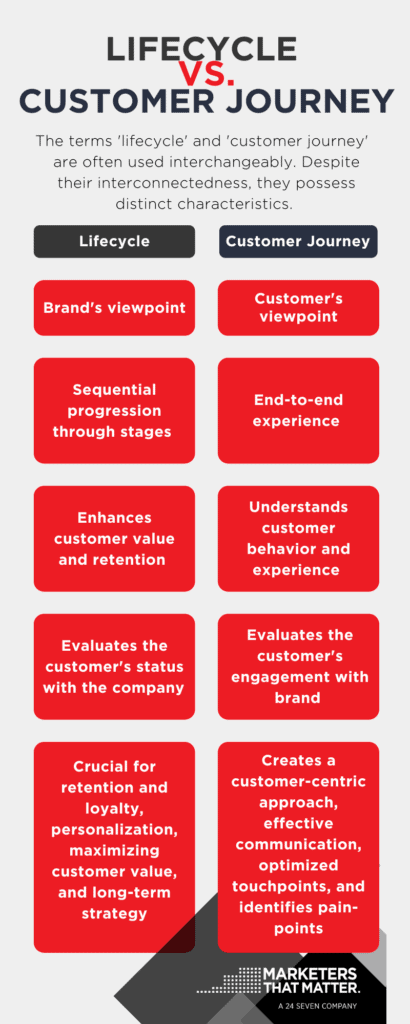In this insightful discussion as part of our Marketer 411 live series, Margaret Lee, Director of Lifecycle Marketing at Chime, and Katie Conrad, General Manager of Destination Marketing at Delta Airlines, share their expertise on modern Lifecycle Marketing. Together, they shed light on the nuances that distinguish Lifecycle Marketing from the Customer Journey, ways to align stakeholders around common goals and how success is measured in the dynamic landscape of Lifecycle Marketing.
Q: How are Lifecycle Marketing and Customer Journey different?
Katie Conrad (Delta):
When we talk about the lifecycle, our main goal is to guide the customer from initial interaction to becoming a loyal customer. You can’t separate Lifecycle Marketing and the Customer Journey. You have to consider the entire process, so you can align your strategies and messaging according to where the customer stands.
The lifecycle as a whole is undoubtedly cyclical. At every stage of the lifecycle, the customer journey is the focal point. In my role, I oversee destination marketing, which forms just one of the four pillars of the entire lifecycle. Each of these pillars has its distinct customer journey. However, when you look at it holistically, you realize that one cannot exist without the other.

Margaret Lee (Chime):
The customer journey is primarily viewed from the customer’s perspective. It involves understanding the end-to-end experience, encompassing various touchpoints where customers engage with your brand as they progress through different stages, like awareness, consideration, and decision-making within the purchase cycle.
On the other hand, the lifecycle is the brand’s viewpoint. It’s a sequential progression, like a sales funnel, that cycles through stages like acquisition and conversion. This active process is managed by lifecycle marketers, aiming to enhance customer value and retention.
Lifecycle orientation is much more about a customer’s status with the company. These designations, like ‘high propensity active customer’ or ‘churn customer,’ aren’t terms customers apply to themselves, but they still hold importance.
Certainly, the terms ‘customer journey’ and ‘lifecycle’ are often used interchangeably, which can be confusing. However, it’s worth noting that you can’t fully grasp one without understanding the other. Despite their interconnectedness, they possess distinct characteristics.
Q: How do you align common goals with stakeholders?
Margaret Lee:
When I think of stakeholders, I envision two primary facets. First, there are stakeholders who may be making requests or those with whom you’re collaborating on campaigns. Lifecycle marketing involves supporting teams that require channel expertise and assistance.
The most effective way to align on a shared goal is to define impact in the same manner. Challenges arise when different teams define impact differently. For instance, one team might focus on driving product adoption for a specific product, while another has a revenue target. Harmonizing these perspectives can be challenging during the intake process and when prioritizing tasks.
Second, there are stakeholders integral to the end-to-end lifecycle process. This includes areas like creative, compliance, legal, and CRM deployment. This complexity can be overwhelming and confusing for lifecycle marketers.
Furthermore, we often need to step in when there are weak links in the process, as we are responsible for shepherding campaigns to fruition. In such cases, working with these internal stakeholders is a mutual effort to simplify processes and make each other’s tasks smoother.
Ultimately, the lifecycle operates as an impartial, data-driven entity with the customer as its focal point. We’re not solely beholden to other teams’ KPIs. Our core responsibility is to navigate and harmonize the array of competing priorities and requests into a coherent customer-centric strategy that aligns with company objectives.
When differing opinions arise with stakeholders, there are pragmatic ways to find common ground. Starting with smaller-scale efforts and validating them before scaling up, or adjusting targeting and experimentation methods, can help bridge gaps when opinions diverge and data is limited.
Katie Conrad:
There are two key points to consider. First, there’s the recognition of how lifecycle works with brand, each playing a crucial role in the broader marketing strategy. Branding entails sharing our story with the total addressable audience to generate equity.
On the other hand, lifecycle focuses on engaging existing customers or prospects showing interest, urging them to take action. This involves creating strategies that align with and complement the brand, incorporating awareness and consideration phases.
It’s impactful to work toward a common objective. At Delta, each vertical has its goals, yet the ultimate focus remains the customer. Engaging customers to enhance loyalty and lifetime value is our primary aim. This necessitates close collaboration with the SkyMiles marketing lead, fostering teamwork and collaboration in the customer’s service and travel experience.
Q: How do you get the right message to the right customer at the right time, and what key principles do you use?
Katie Conrad:
One significant factor, likely unsurprising to everyone here, is the role AI has begun to play for us. AI serves as a valuable tool for scaling our efforts. I was recently at a conference in New York, where a panelist emphasized using AI for tasks that might not appear ‘sexy.’ While AI is capable of producing impressive creative and attractive outcomes, it’s equally effective as a tool for managing backend operations.
For instance, when we’re dispatching emails and messages to millions of SkyMiles members, having the capability to test not just A/B scenarios, but even up to A/B/C/D/E/F/G testing at that scale, provides us with a significant advantage.
This approach allows us to gain insights into our customers and various segments, enabling us to craft tailored messages for the right individuals at the right moment. It’s a pivotal method for enhancing our understanding of customers and optimizing our communication strategies.
Margaret Lee:
We’re just scratching the surface here and haven’t fully mastered it yet. This approach involves three aspects: content, timing, and segmentation. At Chime, our early focus has been on personalization at scale, given our evolving Martech tools. We rely on a mix of push and pull strategies. Constant communication pushes complement pull-based, triggered messages that guide member actions.
For new members, we analyze customer conversion intent and interests. While manual segmentation poses challenges, we concentrate on conversion intent and interest, utilizing data science models, manual signals, explicit and implicit customer cues, like conversion sources or user selections. These strategies allow us to cater content to high conversion intent customers and provide educational content to those with lower intent.
Future ideas encompass refining timing, determining optimal engagement times, suggesting the next best action for each customer’s financial goals, and rapidly testing creative iterations. While large-scale testing is a challenge for us, these steps collectively enhance member engagement and personalization.
Q: How are you leveraging data to inform decisions and measure success?
Katie Conrad:
We’re in the process of building out our customer data platform (CDP), which is critical for unlocking cross-channel messaging. Consumers may not realize they’re being targeted by various functions, but the goal is to enhance our agility and marketing speed.
Marketing at the speed of commerce is essential; we aim to provide consistent and timely messaging to match customer actions. On the research side at Delta, we’re studying post-pandemic travel patterns to understand the modern traveler’s behavior.
I recommend, even for well-established brands like Delta or Chime, to do a quick qualitative audit, rather than quantitative. Both certainly play a strong role within lifecycle marketing as you ultimately want to emotionally bring someone from a first-time user to a loyalist.
Margaret Lee:
In terms of the data, we use for targeting and segmentation, we’ve recently introduced a CDP, although it’s not fully integrated for lifecycle yet. This presents an opportunity for collaboration. Defining members consistently and establishing centralized governance for member attributes has proven to be a challenge at Chime, an ongoing effort to ensure alignment and reliable data sources.
The CDP has an added benefit, enabling marketers to create new segments more efficiently. Often, setting up manual tests and building cases for teams can be time-consuming. The substantial member insights team at Chime enhances member centricity, contributing valuable insights to initiatives. An intriguing idea is to study the member journey from enrollment through onboarding and activation, considering the complex product experience governed by multiple teams.
This prompts us to question if this journey aligns with members’ expectations and where improvements can be made, breaking down inter-team barriers. In measuring success, our primary focus aligns with company goals and secondary metrics that indicate future customer conversion propensity. This approach serves as our guiding star amidst the numerous points we’ve touched on today.
The Marketer 411 virtual events are hosted by Jennie Stark, the VP of the MTM Program at 24 Seven. These events are designed for Marketing Managers to bring value, direction, and inspiration to their teams from insightful conversations with top marketing leaders. Each 411 contains insights on different disciplines, such as what brands are focused on, leading teams, measuring success, and more.
Meet the Experts
Margaret Lee, Director of Lifecycle Marketing at Chime: Margaret Lee leads a talented and scrappy team of marketers who are responsible for activating, onboarding, and converting new members—helping them find immediate value, delight, and confidence and make Chime their primary financial partner. Over her 12+ year career, Margaret has led lifecycle strategy across a diverse set of businesses and challenges—including a health care firm with 25+ products, 3-sided marketplaces, and migrating customers from Postmates to Uber. She resides in San Francisco with her pup Arya and graduated with a degree in Journalism from the University of Maryland.
Katie Conrad, General Manager, Destination Marketing, Delta Airlines: Katie Conrad is a brand storyteller and consumer advocate who loves using data as the building blocks for marketing strategy. With experience in omni-channel marketing strategy, brand partnerships and team leadership, she concepts, builds and executes programs that guide organizations toward growth and optimization. Her expertise has allowed her to serve companies in travel, hospitality, and retail media sectors, like Macy’s, Hilton, and The Ritz-Carlton Hotel Company.
Marketers That Matter® is a community of top marketing executives coming together to pioneer the future of marketing, sharing real-time experiences, and solving current challenges.
Our parent company, 24 Seven, specializes in helping you find exceptional marketing and creative talent for your teams.


